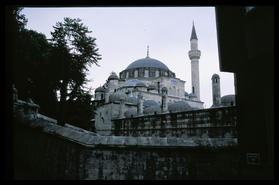 This is just a mosque I ran across walking around the city. It was very differnt to look at a Muslim city from the air when I was flying into Istanbul, because it's studded throughout with six to ten story minarets.
This is just a mosque I ran across walking around the city. It was very differnt to look at a Muslim city from the air when I was flying into Istanbul, because it's studded throughout with six to ten story minarets. 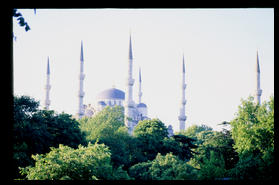 Built over a ten year period from 1609 to 1619, the Blue Mosque, or Sultanahmet Camii, is a jewel of Islamic architechture, is delicately immense.
Built over a ten year period from 1609 to 1619, the Blue Mosque, or Sultanahmet Camii, is a jewel of Islamic architechture, is delicately immense. Its sixteen domes and six minarets are meant to signify that Sultan Ahmet I, was the sixteenth Ottoman sultan, and the sixth since the Ottoman conquest of Istanbul. Visitors are allowed to walk through a section of the floor that amounts to about 20% of the main area; you take your shoes off and are given a bag to carry them in.
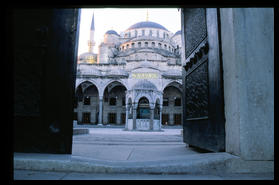 This is the door to the interior courtyard of the Mosque, where an ablutions fountain can be seen.
This is the door to the interior courtyard of the Mosque, where an ablutions fountain can be seen. Modern mosques usually merely have a row of taps inside; most of the major pillars inside the Blue Mosque also have decorative faucets on them.
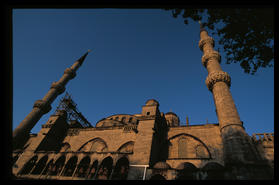 This is the northeast facade of the Blue Mosque. This was my first morning in Istanbul, so I had gotten up well before dawn for photographic purposes -- almost always a rewarding effort.
This is the northeast facade of the Blue Mosque. This was my first morning in Istanbul, so I had gotten up well before dawn for photographic purposes -- almost always a rewarding effort. 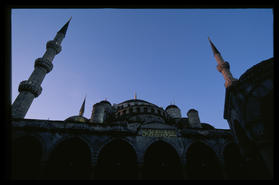
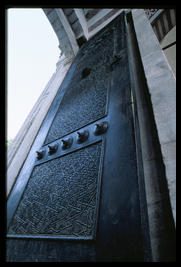 This is the immense door to the courtyard, which seems to be open all the time (or at least at 5 a.m.). It appears to be made of a metal that has a lot of copper in it.
This is the immense door to the courtyard, which seems to be open all the time (or at least at 5 a.m.). It appears to be made of a metal that has a lot of copper in it. 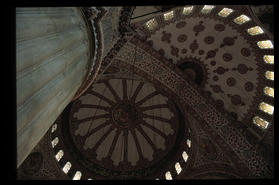 Althogh it appears reddish here, probably from the tungsten lighting, the ceiling and interior of the Mosque are inlaid with blue Iznik tiles, which are made of material that is about 85% quartz and are responsible for the name of the Mosque.
Althogh it appears reddish here, probably from the tungsten lighting, the ceiling and interior of the Mosque are inlaid with blue Iznik tiles, which are made of material that is about 85% quartz and are responsible for the name of the Mosque.The domes were some of the first to sport iron reinforcements, which has helped Sultanahmet Casii survive earthquakes throughout the ages, and there is a giant pool of water underneath it to keep it cool in summer and warm in winter.
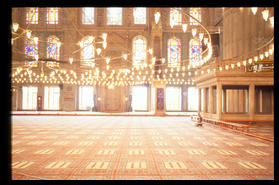 The Blue Mosque was originally lit by candles, and has since been refitted with newer electrical chandeliers.
The Blue Mosque was originally lit by candles, and has since been refitted with newer electrical chandeliers. Note the scale of the vacuum cleaner as compared to the immense are of rugs, and imagine the poor bastard who gets stuck with the a Sisyphean task of vacuuming.
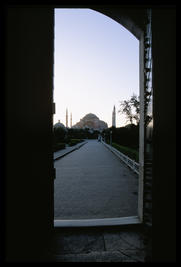 Sultanahmet Casii faces its older sister, Aya Sofya, with Sultanahmet Square in between the two. This is looking out from the Blue Mosque towards Aya Sofya.
Sultanahmet Casii faces its older sister, Aya Sofya, with Sultanahmet Square in between the two. This is looking out from the Blue Mosque towards Aya Sofya. 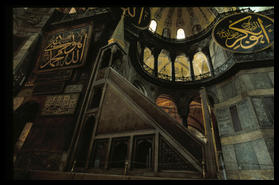 Completed in 537AD under the auspices of Justinian, Aya Sofya was a Byzantine Church resplendant with gilded mosiacs until 1453, the year the Ottomans succeeded in their conquest of Istanbul.
Completed in 537AD under the auspices of Justinian, Aya Sofya was a Byzantine Church resplendant with gilded mosiacs until 1453, the year the Ottomans succeeded in their conquest of Istanbul.
At that time, the mosaics were covered up and Islamic phrases of prayer were mounted on large shields around the interior, and the church became a mosque. It remained so until Ataturk declared it a museum in 1932. The battered gold iconic mosaics of the Byzantines are now again visible in the upper galleries.
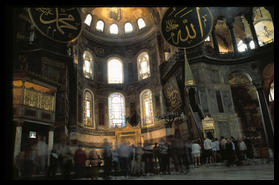 Here you can see the mihrab, which is an Islamic pulpit from which an imam would preach.
Here you can see the mihrab, which is an Islamic pulpit from which an imam would preach. 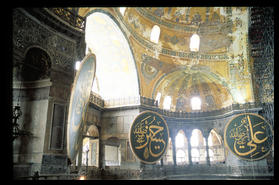 This is the upper dome of Aya Sofya, where you can get some indication of the gilding that is now wearing away. The area around the window is not actually that white, it's an artifact of the exposure.
This is the upper dome of Aya Sofya, where you can get some indication of the gilding that is now wearing away. The area around the window is not actually that white, it's an artifact of the exposure. 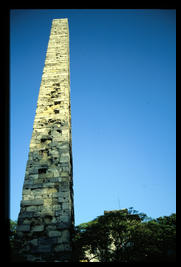 This is one of two obelisks that are in the suken hippodrome that runs parallel to the space in between the two great mosques. According to Lonely Planet, it was formerly covered in bronze plates that were stolen by marauding crusaders.
This is one of two obelisks that are in the suken hippodrome that runs parallel to the space in between the two great mosques. According to Lonely Planet, it was formerly covered in bronze plates that were stolen by marauding crusaders.
The other obelisk looked very new and Egyptian, and I later learned that only one of these was true: it was carved in about 1500 B.C. as part of Karnak Temple in Luxor.
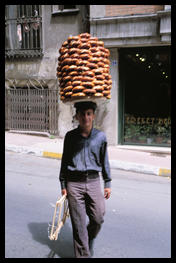 Using one's head is evidently the manner of transporting baked goods in Istanbul. I took three frames in a row of this boy, hoping that one of them would survive the 45th/sec exposure and come out clean. Alas, none did, and this is the bsest.
Using one's head is evidently the manner of transporting baked goods in Istanbul. I took three frames in a row of this boy, hoping that one of them would survive the 45th/sec exposure and come out clean. Alas, none did, and this is the bsest. I survived on the bagel-like things of this kind that were sold ubiquitously throughout Istanbul, but they didn't really seem to be that readily available elsewhere -- come to think about it, getting leavened bread elsewhere was often tricky.
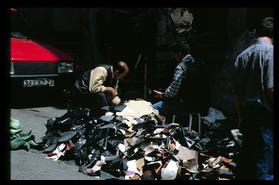 As you walk away from the main part of Istanbul, you also seem to walk down the supply chain of good that are for sale on the main streets: first there are people making shoes, then leather shops like this one, and then rubber makers and finally whole cow hides hanging in windows and outdoors.
As you walk away from the main part of Istanbul, you also seem to walk down the supply chain of good that are for sale on the main streets: first there are people making shoes, then leather shops like this one, and then rubber makers and finally whole cow hides hanging in windows and outdoors. 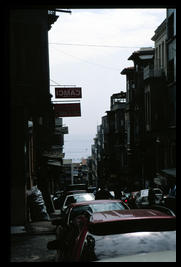 Here is the view of the Sea of Marmara, heading south from Sultanahmet.
Here is the view of the Sea of Marmara, heading south from Sultanahmet. 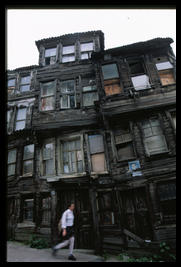 I was amazed at the buildings that are left standing in Istanbul. I don't know if they have odd historical-monument laws or what, but there will be normal looking almost-European looking buildings, and some that look decrepit, but then there were more than a few of these wooden structures that should definitely have burned or suffered some kind of internal structural collapse. I'd rather be camping on an empty lot than try to live in one of these suckers.
I was amazed at the buildings that are left standing in Istanbul. I don't know if they have odd historical-monument laws or what, but there will be normal looking almost-European looking buildings, and some that look decrepit, but then there were more than a few of these wooden structures that should definitely have burned or suffered some kind of internal structural collapse. I'd rather be camping on an empty lot than try to live in one of these suckers. 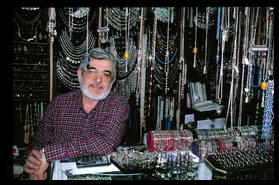 This is in the main bazaar of Istanbul, which I thought was the best place to buy things. The Turkish lira is very much devalued, so goods are cheap, the merchants speak more than passable English and the goods are of higher quality than in Damascus or Cairo.
This is in the main bazaar of Istanbul, which I thought was the best place to buy things. The Turkish lira is very much devalued, so goods are cheap, the merchants speak more than passable English and the goods are of higher quality than in Damascus or Cairo. I purchased a couple of small silver boxes from this fellow.
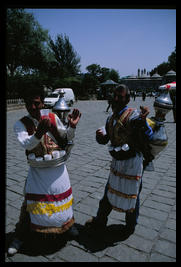 These two guys were tourist predators, but I took a picture of them anyway; they were selling crap coolaid from their traditional-looking pouring things that I imagine were intended for use with tea. A cop came up and tried to shoo them away from me, but they followed me still for about two blocks, waiting for a million lira tip, or about one dollar.
These two guys were tourist predators, but I took a picture of them anyway; they were selling crap coolaid from their traditional-looking pouring things that I imagine were intended for use with tea. A cop came up and tried to shoo them away from me, but they followed me still for about two blocks, waiting for a million lira tip, or about one dollar.While I'm on the subject of Turkish currency, I should mention that I later saw a waiter burst out of a restaurant, chasing after some patrons that had just left. The customer had confused the number of zeroes on one of the bills he was carrying, and had left a 500,000 bill where a 5,000,000 was needed -- something I had almost done several times, since the problem is exacerbated by the fact that they don't use commas.
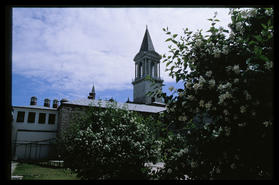 This is Topkapi palace, which, along with Aya Sofya, is one of the great tourist attractions of Istanbul.
This is Topkapi palace, which, along with Aya Sofya, is one of the great tourist attractions of Istanbul.
It is the archetypical sultan's palace, with an open plan of many buildings and partly-enclosed areas that take advantage of the mild climate provided by the nearby seas.
It also has a harem, which, contrary to popular conception, is merely the "family" area of the home, where women can feel free to leave their faces uncovered and the Sultan can relax, away from his duties in the world.
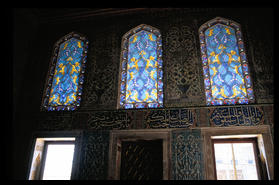 These are the windows in the equivalent of the price-regent (I forget the actual Ottoman title)'s chambers. Note also the intricate tile work on the walls.
These are the windows in the equivalent of the price-regent (I forget the actual Ottoman title)'s chambers. Note also the intricate tile work on the walls. 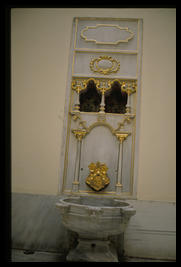 This is the privy of the sultan, complete with a tap presumably used for flushing of sorts.
This is the privy of the sultan, complete with a tap presumably used for flushing of sorts. 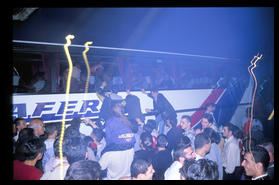 When I was leaving Istanbul, we first stopped at an otogar, or bus station, just outside of the City.
When I was leaving Istanbul, we first stopped at an otogar, or bus station, just outside of the City. For whatever reason, these people were having some kind of celebration there that involved climbing on every bus that arrived and ...
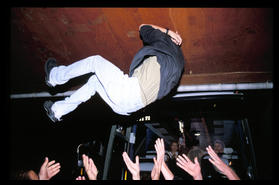 ... flinging each other in the air. They were doing this outside of the enclosed area as we arrived, and another woman on my bus (a Turkish woman, I'm just taking the equivalent of Greyhound here) asked to take a picture of it. So they immediately obliged underneath the covered sidewalk and immediately flung this poor bloke directly into the ceiling. He appeared dazed but happy.
... flinging each other in the air. They were doing this outside of the enclosed area as we arrived, and another woman on my bus (a Turkish woman, I'm just taking the equivalent of Greyhound here) asked to take a picture of it. So they immediately obliged underneath the covered sidewalk and immediately flung this poor bloke directly into the ceiling. He appeared dazed but happy. My going theory on the celebration, which I couldn't really confirm while I was there, was that the Turks won some kind of football match, since the owner of the pension where I was staying was watching the games regularly while I was there and telling me how the Istanbul team was doing in the Nationals.
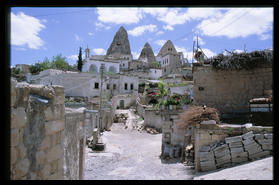 And so I arrived in Goreme, a town in the region of Cappadocia, which is about two hours southeast of Ankara and quite famous for it's soft-rock formations. You can see several of them here; many of the residences and pensions in Goreme are carved directly out of the rock.
And so I arrived in Goreme, a town in the region of Cappadocia, which is about two hours southeast of Ankara and quite famous for it's soft-rock formations. You can see several of them here; many of the residences and pensions in Goreme are carved directly out of the rock.The Goreme open-air museum has several churches that are carved into the rock, complete with domes like a normal Byzantine church, albeit smaller. Most of it is fairly flooded with tourists, and I had to wait around and then squeeze in with groups of German mass-tourists to get a look at several of them.
However, the Dark Church, which requires another $8 admission or so, is well worth it, as it puts all the others to shame and due to the extra price you all but have it to yourself. I spent at least twenty minutes gazing at the symbolic gilded icons painted as a fresco on the rock, depicting various scenes from the New Testament. Like Nefertari's tomb, I really wished that I had learned more about what the painter was trying to symbolize with some of the scenes, and what the meaning of the gestures and movements of the people were.
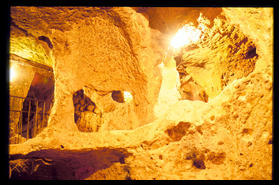 About twenty miles from Goreme is the town of Derinkuyu, which has one of two towns nearby that have deep caves that were used by early Christians as underground cities to avoid marauders (the other is Kaymakli).
About twenty miles from Goreme is the town of Derinkuyu, which has one of two towns nearby that have deep caves that were used by early Christians as underground cities to avoid marauders (the other is Kaymakli). Derinkuyu was something like seven stories deep and meant to house what must have been at least hundreds of people.
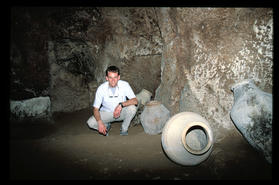 Here I am in the winemaking room of derinkuyu, where there is a depression in the floor for crushing grapes, as well as urns for the finished product.
Here I am in the winemaking room of derinkuyu, where there is a depression in the floor for crushing grapes, as well as urns for the finished product. 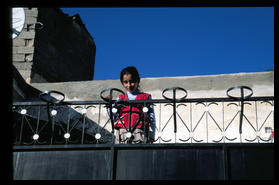 Here is the first of many children that approached me, interested in having their picture taken. This one was standing up high on a balcony of her home.
Here is the first of many children that approached me, interested in having their picture taken. This one was standing up high on a balcony of her home. 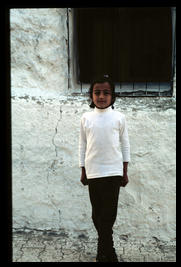 And another nearby, walking past on the street.
And another nearby, walking past on the street. 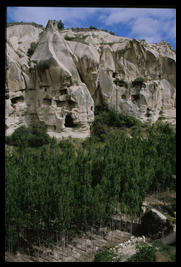 The landscape all around can only be compared to the moon... except there are trees and people have carved residences into it. It's not all confined to the open-air museum, either; I walked out into the countryside nearby and found a rock that had a small domed room cut into the rock, with a rock that served as a seat and a afded icon of Jesus over it. I read about half of Tom Robbin's Even Cowgirls Get the Blues there.
The landscape all around can only be compared to the moon... except there are trees and people have carved residences into it. It's not all confined to the open-air museum, either; I walked out into the countryside nearby and found a rock that had a small domed room cut into the rock, with a rock that served as a seat and a afded icon of Jesus over it. I read about half of Tom Robbin's Even Cowgirls Get the Blues there. 